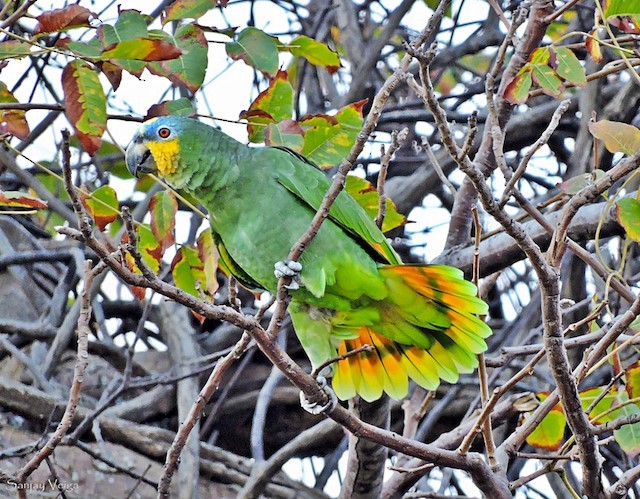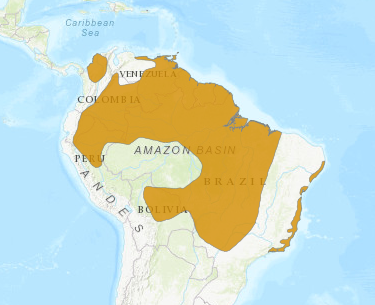Birdfinding.info ⇒ The commonest Amazona across much of its extensive range, and possibly the most numerous globally. Locally abundant in many areas: especially on Trinidad, Tobago, the coastal plain of the Guianas and Amapá, and along the major rivers and savanna zones of Amazonia. In Florida, it is found mainly in urban parks from Pompano Beach to South Miami—consistent sites include Miami Springs, Brewer Park, and Matheson Hammock.
Orange-winged Parrot
Amazona amazonica
Tropical lowlands of South America, where it is widespread and common in savannas, swamps, floodplains, open woodlands, forest edges, mixed agricultural land, and settled areas.
Occurs from the intermontane valleys of western Colombia east through Venezuela, Trinidad & Tobago, and the Guianas to Maranhão, and south through the Amazon Basin and cerrado biome to Bolivia, Paraguay, Paraná, and São Paulo.
Also on Brazil’s coastal plain from Rio Grande do Norte to Paraná, but mostly absent from the arid and hilly regions of eastern Brazil.
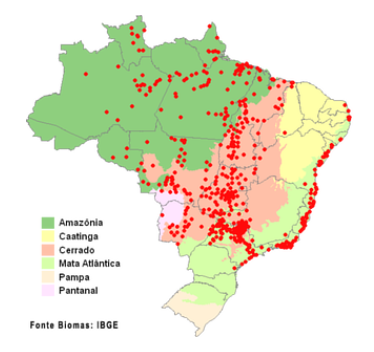
Brazilian records from © WikiAves
Adapts fairly well to some forms of development that result in open areas with scattered trees. Introduced populations appear well established in southeastern Florida, Puerto Rico, Martinique, Grenada, and Curaçao.
Identification
Mostly green with a yellow-and-blue face, and yellow and orange in the tail.
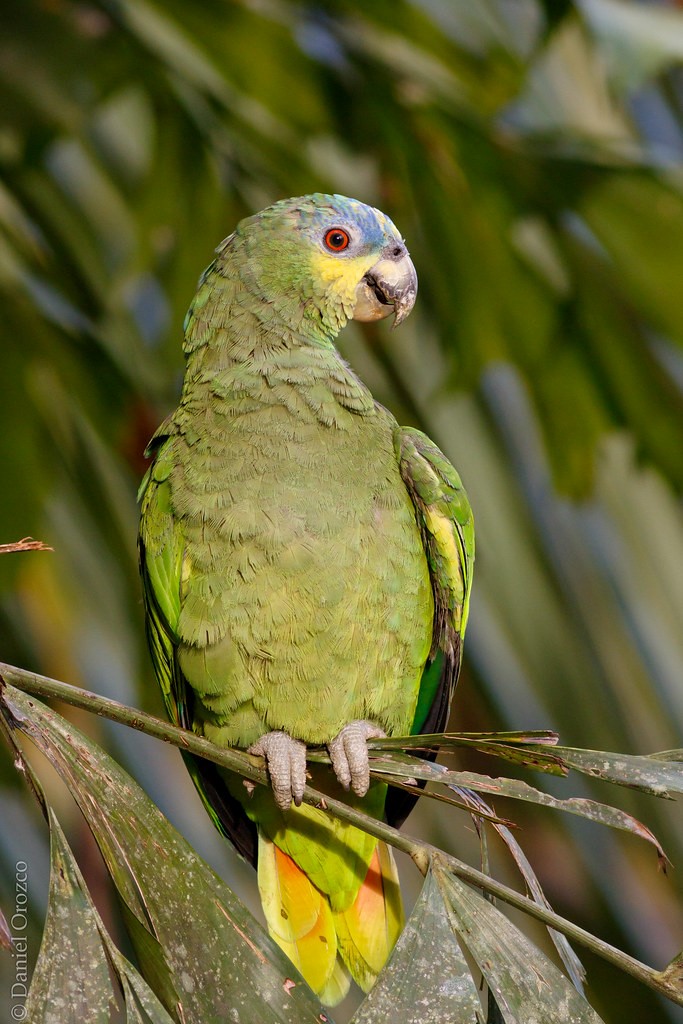
Orange-winged Parrot, showing typical yellow-and-blue face and yellow-and-orange undertail. (Torrelavega, Colombia; December 8, 2017.) © Daniel Orozco
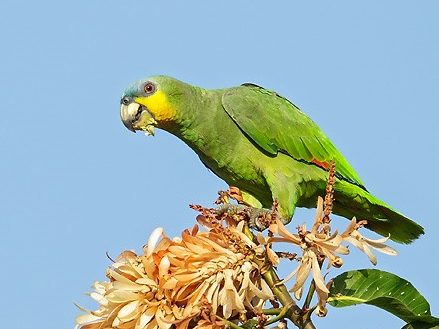
Orange-winged Parrot, with no yellow showing in the crown. (Guyana; November 9, 2016.) © Glenn Bartley

Orange-winged Parrot. (Laguna del Yuturi, Orellana, Ecuador; February 9, 2019.) © Susan Mac
The blue in the face often forms a “visor” between the yellow cheek and yellow crown, but many individuals have all-blue or mixed yellow-and-blue crowns.
The bill is typically bicolored: mostly dark with a pale tan or horn-colored patch on the upper mandible. The lower mandible varies from dark to pale.
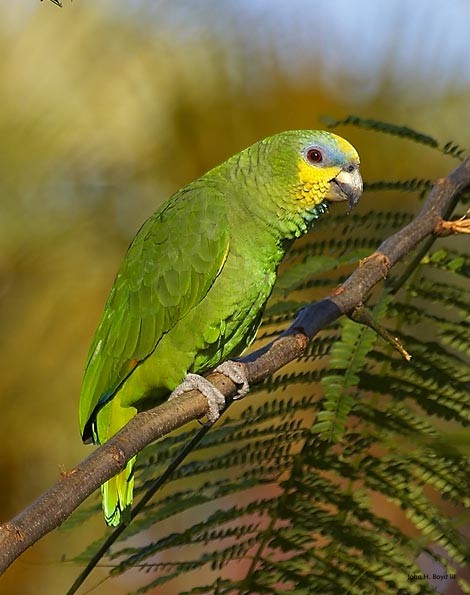
Orange-winged Parrot, showing blue “visor” between yellow crown and cheek—note the bicolored upper mandible. (Miami Springs, Florida; March 28, 2004.) © John H. Boyd III

Orange-winged Parrot, with dirt obscuring its facial pattern—note the bicolored upper mandible. (Cuffie River Nature Retreat, Tobago; March 1, 2018.) © Paul Tavares
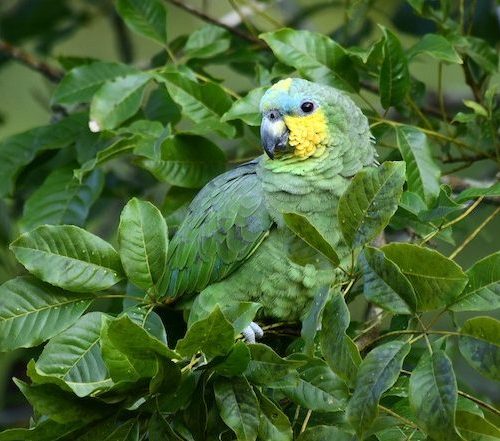
Orange-winged Parrot, showing a mostly blue crown with a small yellow patch—note the bicolored upper mandible. (Fazenda Santa Teresa, Espírito Santo, Brazil; September 7, 2017.) © Luiz Moschini
Tail color and pattern vary. Typically, the underside of the tail is orange at the base and yellow at the tip, and the upperside is green at the base and yellow or yellowish-green at the tip. In some individuals—maybe related to sex, age, or molt stage—the tail may appear all or mostly green, especially the upperside, usually with some hints of yellow or orange on the underside.
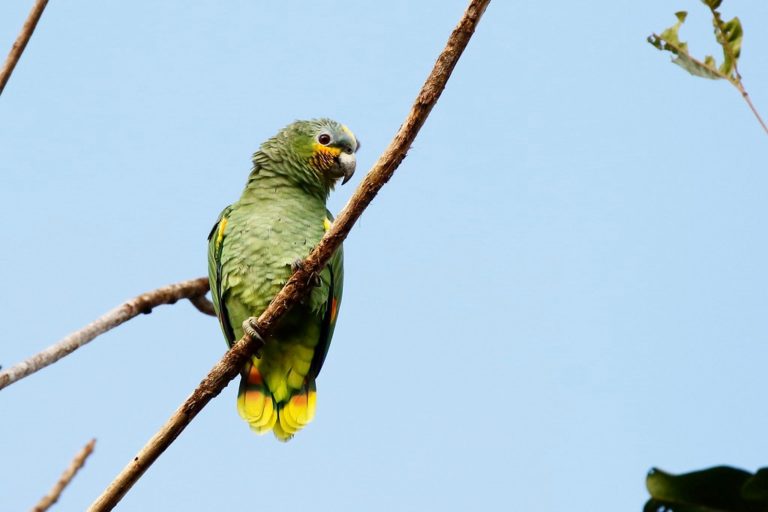
Orange-winged Parrot, showing its orange-and-yellow undertail. (Cuyabeno, Ecuador; September 24, 2016.) © Rolf Riethof
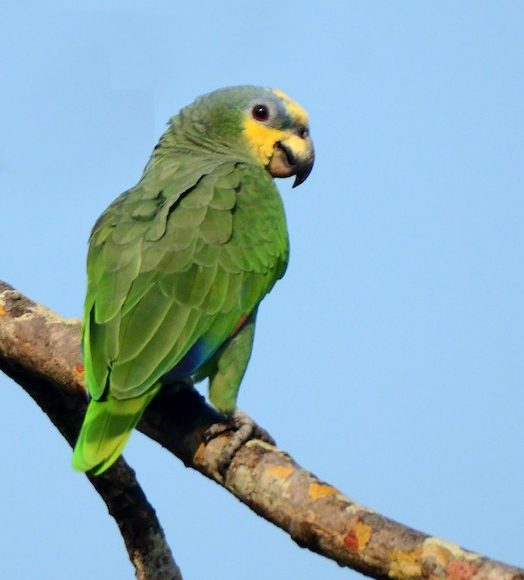
Orange-winged Parrot, showing green uppertail. (Matheson Hammock Park, Miami, Florida; March 23, 2015.) © Steven Mlodinow
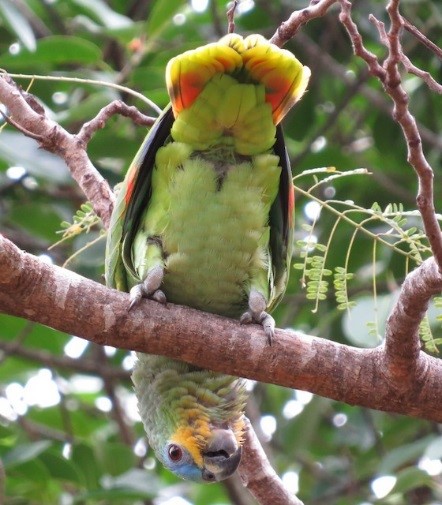
Orange-winged Parrot, showing its orange-and-yellow undertail. (Fuchs Park, Miami, Florida; March 28, 2016.) © Susan Disher

Orange-winged Parrot, showing its broad wings and orange-and-yellow undertail. (Matheson Hammock Park, Miami, Florida; February 21, 2016.) © Nathan Langwald
The wings are remarkably broad and the uppersides have small reddish orange patches in the outermost secondaries—the understated feature for which it is named.

Orange-winged Parrot, showing the small orange wing-patches for which it is named—also note that this individual has an all-blue crown. (Sani Lodge, Sucumbíos, Ecuador; November 28, 2014.) © Suzanne Labbé
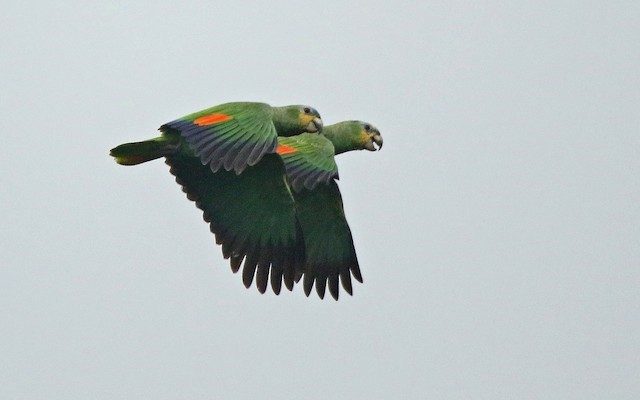
Orange-winged Parrot, pair showing their eponymous orange wing-patches. (Sani Lodge, Sucumbíos, Ecuador; November 19, 2017.) © Roger Ahlman

Orange-winged Parrot, showing the typical lack of distinguishing features on its underwing—and lacking evident yellow in the folded tail, this bird is best identified by its facial pattern. (Matheson Hammock Park, Miami, Florida; March 23, 2015.) © Steven Mlodinow
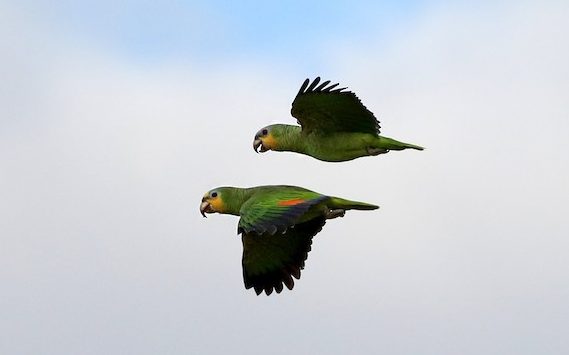
Orange-winged Parrot, pair with one bird showing a typical view of the orange wing-patch—better identified by facial pattern in this photo. (Serra das Araras, Mato Grosso, Brazil; July 30, 2017.) © Charley Hesse TROPICAL BIRDING
Voice. Calls are raucous and varied, many with a rolling, vibrato texture, e.g.: Common flight calls include a squeaky two-syllable bark, repeated over and over: kee-kick! kee-kick! Also gives squeaky one-syllable flight calls, repeated over and over: churt! churt! churt! churt!
Cf. Turquoise-fronted Parrot. Turquoise-fronted and Orange-winged Parrots overlap widely in Brazil, Bolivia, and Paraguay. Due in part to variation within both species, they are readily confused. If seen clearly, however, they are distinguishable:
Facial Pattern: Given an opportunity for close study, details of the facial pattern and coloration are diagnostic. Both have variable amounts of blue and yellow. The key difference is that Orange-fronted always has yellow below the eye and blue besides and above the eye, whereas Turquoise-fronted’s eye is surrounded by yellow (or occasionally no yellow in the face).
Wings: Despite its name, the reddish-orange wing-patch is not the Orange-winged’s most reliable field mark, as the Turquoise-fronted has a similar, but slightly larger, red patch on its wings. Depending on the subspecies and age, Turquoise-fronted’s wings usually have a differently colored shoulder, often visible in flight as the leading edge of the wing. Throughout most of Brazil, the leading edge is red or orange. In Bolivia, Paraguay, Argentina, and adjacent parts of Brazil, xanthopteryx has a yellow shoulder, and the leading edge is yellow above, and red or orange below (with largely yellow wing linings).
Bill: Turquoise-fronted usually has an all-black bill. Orange-winged has a prominent pale patch on the upper mandible—sometimes also a pale patch on the lower mandible. Some Turquoise-fronted show a somewhat pale upper mandible, but it is usually grayish (i.e., black but abraded) whereas on Orange-winged the patch is more tan or horn-colored.
Tail: The tail patterns of both species are somewhat variable and usually difficult to discern. If seen well, the clearest difference is the Turquoise-fronted has distinct tail bands: red (or red-and-green) at the base, dark in the middle, and pale green at the tips. Orange-fronted often has a dark tail band in the middle of the tail, but it is usually narrower and less distinct.
Notes
Polytypic species consisting of two recognized subspecies.
References
Alderfer, J., and J.L. Dunn. 2014. National Geographic Complete Birds of North America (Second Edition). National Geographic Society, Washington, D.C.
Ascanio, D., G.A. Rodriguez, and R. Restall. 2017. Birds of Venezuela. Christopher Helm, London.
BirdLife International. 2018. Amazona amazonica. The IUCN Red List of Threatened Species 2018: e.T22686350A131920257. http://dx.doi.org/10.2305/IUCN.UK.2018-2.RLTS.T22686350A131920257.en. (Accessed May 4 2019.)
Collar, N., and P. Boesman. 2018. Orange-winged Amazon (Amazona amazonica). In Handbook of the Birds of the World Alive (J. del Hoyo, A. Elliott, J. Sargatal, D.A. Christie, and E. de Juana, eds.). Lynx Edicions, Barcelona. https://www.hbw.com/node/54751. (Accessed March 3, 2018).
ffrench, R. 2012. A Guide to the Birds of Trinidad & Tobago (Third Edition). Cornell University Press. Ithaca, N.Y.
Forshaw, J.M. 2010. Parrots of the World. Princeton University Press, Princeton, N.J.
McMullan, M., and T. Donegan. 2014, Field Guide to the Birds of Colombia (Second Edition). Fundación Proaves de Colombia, Bogotá.
Schulenberg, T.S., D.F. Stotz, D.F. Lane, J.P. O’Neill, and T.A. Parker. 2007. Birds of Peru. Princeton University Press, Princeton, N.J.
van Perlo, B. 2009. A Field Guide to the Birds of Brazil. Oxford University Press, Oxford.
Wells, J.V., and A.C. Wells. 2017. Birds of Aruba, Bonaire, and Curaçao. Cornell University Press, Ithaca, N.Y.
WikiAves, Curica, http://www.wikiaves.com.br/curica.
